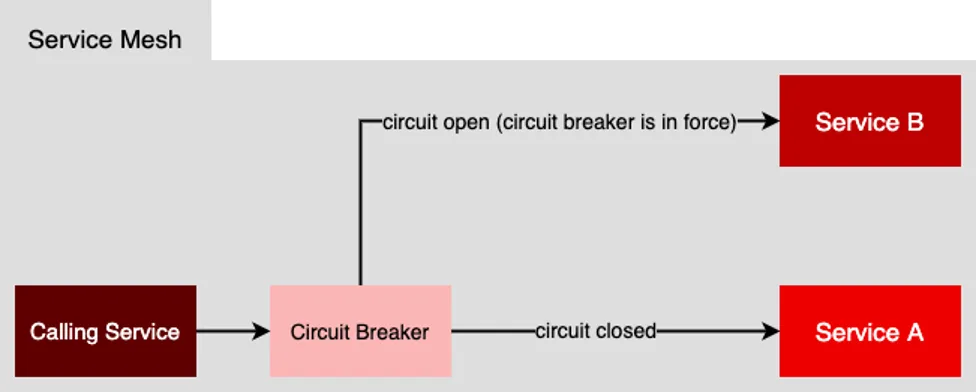Having a grasp of common architectural patterns is essential to designing software architecture at scale. Using them saves not only time but also ensures a reliable implementation of your design. There’s no need to reinvent the wheel when there’s an architectural pattern available that applies to an architecture you’re developing.
The following is a brief overview of the Circuit Breaker architectural pattern.
Understanding the Circuit Breaker pattern
The Circuit Breaker pattern is one in which an intermediary service is placed between a caller and a target. The purpose of the intermediary service is to observe conditions in the target. Should hazard occur, the circuit breaker process reroutes traffic to another service that has the logic to mitigate the hazardous condition.

Analogically, the pattern is similar to a physical circuit breaker for electric lines. When an electric line becomes overloaded and runs the risk of overheating and causing a fire, the circuit breaker trips and stops electricity from flowing through the circuit’s wire.
Pros
- Using a circuit breaker to respond to the onset of a hazardous condition in a fault tolerant manner is an excellent way to prevent accidents before they happen.
- Provides a good way to make systems fault-tolerant at a fine level of activity.
Cons
- Testing can be harder than it appears. More is required than simply having the circuit breaker close down access to a particular service. A variety of failure responses need to be in force and these responses need to be tested.
- Circuits are difficult to do as a one-off. They require an infrastructure management technology such as a service mesh that can manage the switching on and off.
Putting it all together
In terms of addressing failure at a general application level, relying on each process in the system to accommodate failure is a time-consuming undertaking. Making updates at the process level is even more laborious. Using the Circuit Breaker pattern in conjunction with a system management technology such as a service mesh allows software architects to take a global approach to creating fail-safe systems.
저자 소개
Bob Reselman is a nationally known software developer, system architect, industry analyst, and technical writer/journalist. Over a career that spans 30 years, Bob has worked for companies such as Gateway, Cap Gemini, The Los Angeles Weekly, Edmunds.com and the Academy of Recording Arts and Sciences, to name a few. He has held roles with significant responsibility, including but not limited to, Platform Architect (Consumer) at Gateway, Principal Consultant with Cap Gemini and CTO at the international trade finance company, ItFex.
채널별 검색
오토메이션
기술, 팀, 인프라를 위한 IT 자동화 최신 동향
인공지능
고객이 어디서나 AI 워크로드를 실행할 수 있도록 지원하는 플랫폼 업데이트
오픈 하이브리드 클라우드
하이브리드 클라우드로 더욱 유연한 미래를 구축하는 방법을 알아보세요
보안
환경과 기술 전반에 걸쳐 리스크를 감소하는 방법에 대한 최신 정보
엣지 컴퓨팅
엣지에서의 운영을 단순화하는 플랫폼 업데이트
인프라
세계적으로 인정받은 기업용 Linux 플랫폼에 대한 최신 정보
애플리케이션
복잡한 애플리케이션에 대한 솔루션 더 보기
가상화
온프레미스와 클라우드 환경에서 워크로드를 유연하게 운영하기 위한 엔터프라이즈 가상화의 미래
